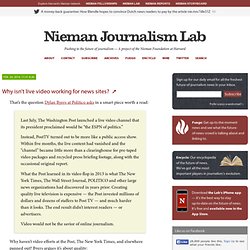

Vice News tells journalists' stories in animated series. Illustrations tell the private stories of international journalists Credit: Image by TapiF on Flickr.

Some rights reserved The private stories of international journalists rarely make the cut in conventional news. But Correspondent Confidential, an illustrated documentary series from Vice News, makes these unique reporting experiences the focus of its episodes. Series producer Carrie Ching said she knows first hand from working with investigative journalists that some of the best stories do not go into the final piece.
Ching said that personal stories provide a lot of insight into the process of reporting, but because of the idea that journalism is meant to be objective they are often missing. Vice News wants to take documentary-style storytelling to hot spots around the globe. If there’s a mantra for the team behind Vice News, it might be: Go where the story takes you. The soon-to-launch news channel from Vice is designed for the type of journalist who wants to strap a camera to her back and jump head first into a conflict zone. Working at Vice Media Is Not As Cool As It Seems. Vice to Launch Digital Sports Channel, Highlights 4 New Original Shows.
Vice, the hipster digital media company and studio aimed at Gen Y audiences, is set to launch a sports channel this summer — promising a journalistic deep-dive into drama on and off the field — and called out four new series it has in the works.

“We’re the first, I believe, platform-agnostic company out there… Mobile, online, TV, film — we’re coming,” Vice founder and CEO Shane Smith said, unveiling the new initiatives to marketers at the company’s first Digital Content NewFronts presentation Friday. “All we care about is making great content.” According to Smith, HBO has renewed the “Vice” newsmagazine show for a third season.
Full Coverage of the 2014 Digital Content NewFronts Vice has nearly 7 million subscribers on YouTube, noted chief creative officer Eddy Moretti: “Vice proves that online video works… Our mission in everything we do is to create a living, breathing chronicle of our times,” Moretti said. Vice Continues to Grow as It Heads Into Its First NewFronts.
Since its humble beginnings as a Montreal-based print publication on news and culture, Vice has mushroomed to 129 million views per month across its platforms, which include online channels, TV shows, its tablet and mobile offerings, and the original magazine (not to mention Vice Music, Film and Books).

Vice’s digital mission for next year, which will be unveiled at its first NewFronts presentation on May 2, is all about expansion, especially for recently launched site Vice News and food vertical Munchies. Chief creative officer Eddy Moretti asserts that no publisher has kept up with how prevalent food has become in youth culture. Vice journalist launches Taggly app to watermark images and video. Vice Media's Tim Pool, a specialist in mobile technology who reported from 2013's Istanbul protests using Google Glass, has launched an app for the proper accreditation and verification of digital news footage.

Taggly, available for iOS, automatically stamps the author's name onto an image or video, alongside the date, time and location they were taken and a company logo. "I needed this," Pool told Journalism.co.uk. "With my photos I'm getting 50 to 100 retweets and there's no way for anyone to know the photo was mine, I'm not getting credit for it and then it's getting picked up and put on news websites and I'm thinking how do I get my website on there.
" TV Real - Articles. Is Shane Smith the next Rupert Murdoch? 16 March 2014Last updated at 20:04 ET By Will Smale Business reporter, BBC News.

Why isn’t live video working for news sites? That’s the question Dylan Byers at Politico asks in a smart piece worth a read: Last July, The Washington Post launched a live video channel that its president proclaimed would be “the ESPN of politics.”Instead, PostTV turned out to be more like a public access show.

Within five months, the live content had vanished and the “channel” became little more than a clearinghouse for pre-taped video packages and recycled press briefing footage, along with the occasional original report.What the Post learned in its video flop in 2013 is what The New York Times, The Wall Street Journal, POLITICO and other large news organizations had discovered in years prior: Creating quality live television is expensive — the Post invested millions of dollars and dozens of staffers to Post TV — and much harder than it looks. The end result didn’t interest readers — or advertisers.Video would not be the savior of online journalism.
There’s truth to that, but let me shade that argument a little. Why live video won't save the news biz - Dylan Byers. Last July, The Washington Post launched a live video channel that its president proclaimed would be “the ESPN of politics.”

Instead, PostTV turned out to be more like a public access show. Within five months, the live content had vanished and the “channel” became little more than a clearinghouse for pre-taped video packages and recycled press briefing footage, along with the occasional original report. Continue Reading What the Post learned in its video flop in 2013 is what The New York Times, The Wall Street Journal, POLITICO and other large news organizations had discovered in years prior: Creating quality live television is expensive — the Post invested millions of dollars and dozens of staffers to Post TV — and much harder than it looks.
Vice News Quickly Makes Mark With Ukraine Dispatches. NEW YORK –- Vice News correspondent Simon Ostrovsky has reported extensively through Central Asia, the Middle East and the Caucasus region, but says he’s never encountered as much hostility as he has covering the Russian invasion of Crimea. “I think it’s because of the propaganda that Russia is broadcasting over the television networks 24/7, brainwashing the people out here into thinking that the entire world has come out against Russia,” Ostrovsky told HuffPost in a phone interview from the Crimean capital of Simferopol.
That hostility shines through in Ostrovsky’s compelling video series for the just-launched Vice News channel, titled “Russian Roulette: The Invasion of Ukraine.” In one dispatch, Ostrovsky has a tense exchange with a Russian soldier trying to prevent his crew from filming. In another, a group of pro-Russian demonstrators throw his press card on the ground and stamp on it. But the most harrowing moment comes in the sixth dispatch. Vice News Debuts, and Anchors Need Not Apply. 5 raisons pour lesquelles Vice Media réussit là où tous les autres médias ont échoué.
Le groupe est passé, en l'espace de 20 ans, du statut de fanzine punk à celui d'empire médiatique.

Au point d'envisager aujourd'hui une introduction en bourse. Créé en 1994, le fanzine punk "The Voice of Montreal" est devenu vingt ans plus tard un empire médiatique d'envergure. Celui qui se baptise désormais Vice Media représente aujourd'hui une audience de près de 9,5 millions de visiteurs uniques dans le monde, selon Comscore... et envisage même une introduction en bourse. "Nous serions stupides de ne pas tester le marché" a déclaré Shane Smith, le cofondateur du groupe dans une interview sur Bloomberg TV.